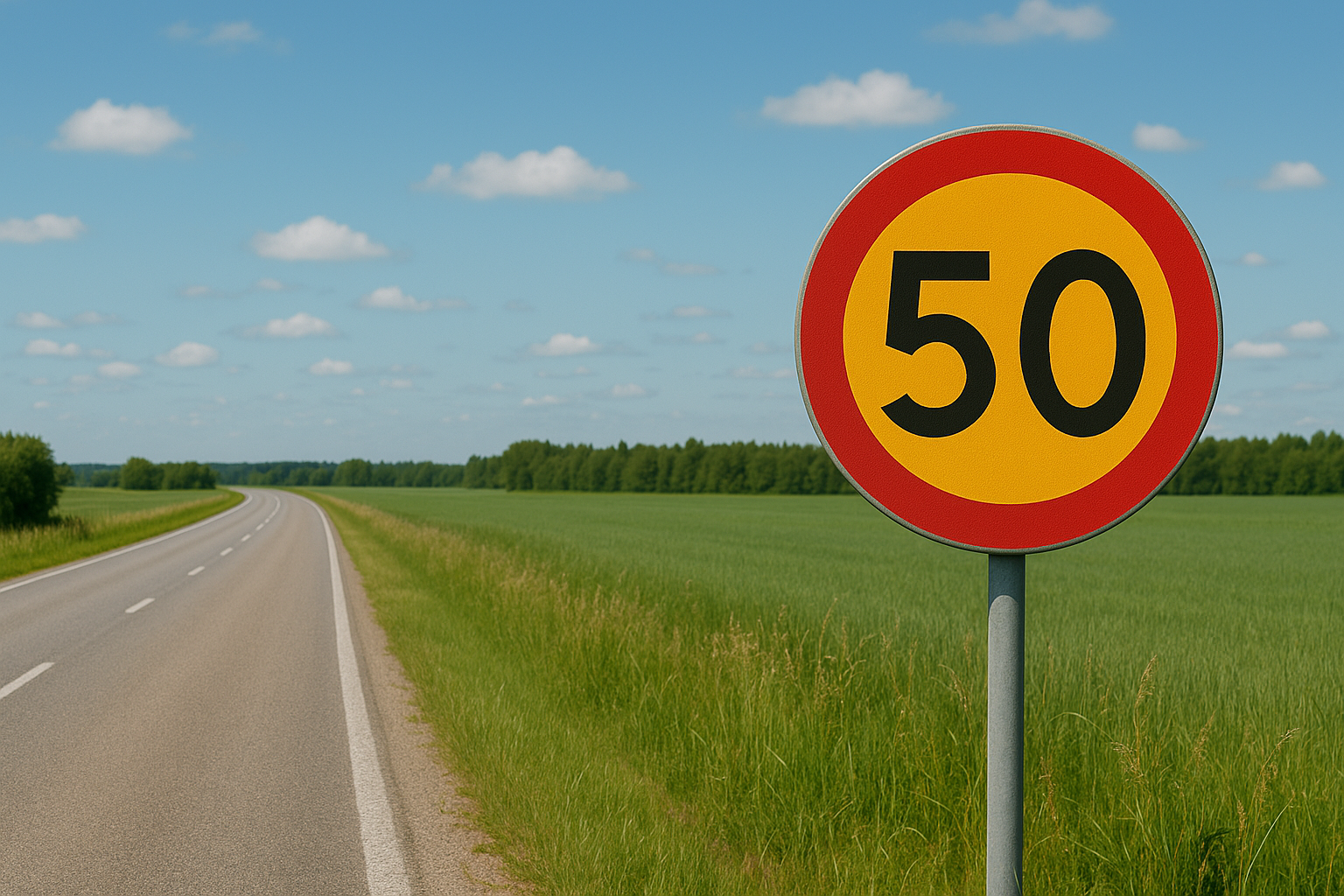Swedish Speed Limits & Safe Distances: Your Complete Guide
Understanding speed limits and maintaining proper safe distances are among the most fundamental skills for safe driving in Sweden. These concepts form the backbone of traffic safety and appear frequently in both theory tests and real-world driving situations. This comprehensive guide breaks down everything you need to know about Swedish speed regulations and distance keeping.
1. General Speed Limits in Sweden

Sweden has established clear general speed limits that apply when no other signs are present. These defaults ensure consistent speeds across similar road types throughout the country.
| Road Type | General Limit | Notes |
|---|---|---|
| Built-up areas | 50 km/h | Applies within city/town boundaries |
| Rural roads | 70 km/h | Outside built-up areas, unless signed otherwise |
| Motorways (Motorväg) | 110 km/h | Some sections may be 120 km/h with specific signing |
| Expressways (Motortrafikled) | 90 km/h | Dual carriageways with limited access |
2. Specific Speed Limits and Situations
School Zones and Residential Areas
In areas with high pedestrian activity, especially near schools during arrival and dismissal times, speed limits are often reduced to 30 km/h. These zones are clearly marked with signs showing the specific times when the lower limit applies.
Road Works and Temporary Limits
Construction zones typically have reduced speed limits for worker safety. These temporary limits are enforceable even when workers aren't present, as equipment and altered road conditions still pose hazards.
Vehicle-Specific Limits
| Vehicle Type | General Limit | Motorway Limit |
|---|---|---|
| Cars with trailers | 80 km/h | 80 km/h |
| Heavy vehicles (>3.5t) | 80 km/h | 80 km/h |
| Buses | 80 km/h | 90 km/h |
3. Safe Following Distances: The 2-Second Rule
The 2-second rule is the standard method for maintaining safe following distances in good conditions. This time-based approach automatically adjusts for your speed, unlike fixed distance measurements.
How to Apply the 2-Second Rule
- Watch the vehicle ahead pass a fixed point (signpost, bridge, shadow)
- Count "one-thousand-one, one-thousand-two"
- You should not reach the same point before finishing the count
- If you arrive too soon, increase your following distance
Why Time Instead of Distance?
Using seconds rather than meters accounts for your speed. At 50 km/h, 2 seconds equals about 28 meters. At 110 km/h, it's approximately 61 meters. The rule automatically provides greater distance at higher speeds where stopping distances increase dramatically.
4. Adapting for Weather and Road Conditions
Safe driving requires adjusting both speed and following distance based on conditions. The general 2-second rule applies only to ideal conditions—you must increase distances in poor weather.
| Condition | Recommended Distance | Speed Reduction |
|---|---|---|
| Wet roads | 4 seconds | Reduce 10-20 km/h |
| Snow/Ice | 6-8 seconds | Reduce 30-50% |
| Fog/Heavy rain | 4+ seconds | Reduce to visibility distance |
| Night driving | 3 seconds | Consider reduced speed |
5. Stopping Distance Calculations
Understanding total stopping distance helps explain why safe following distances are so important. Stopping distance consists of two components:
Reaction Distance + Braking Distance = Total Stopping Distance
| Speed | Reaction Distance | Braking Distance | Total Stopping Distance |
|---|---|---|---|
| 50 km/h | 14 m | 14 m | 28 m |
| 70 km/h | 19 m | 27 m | 46 m |
| 90 km/h | 25 m | 45 m | 70 m |
| 110 km/h | 31 m | 67 m | 98 m |
Reaction distance is the distance traveled during your perception and reaction time (about 1 second for alert drivers). Braking distance is the distance needed to stop once brakes are applied.
6. Theory Test Questions and Strategies
Speed and distance questions are common on Swedish driving theory tests. Understanding the principles behind these rules will help you answer correctly, even when questions are worded differently.
Common Question Types
- Calculation questions: "At 90 km/h, what is your approximate stopping distance on dry asphalt?"
- Scenario questions: "It's raining heavily. How should you adjust your following distance?"
- Rule application: "When does the general speed limit of 50 km/h apply?"
- Exception identification: "In which situation may you exceed the posted speed limit?"
Answering Strategy
Always choose the safest, most conservative option when in doubt. The theory test prioritizes safety over convenience or speed.
7. Common Mistakes to Avoid
- Tailgating in queues: Maintaining proper distance even in slow traffic prevents chain-reaction collisions
- Misjudging winter distances: Assuming 2-second rule works on ice (it doesn't—need 6-8 seconds)
- Speed limit confusion: Forgetting that specific signs override general limits
- Inadequate adjustments: Not increasing distance enough for conditions
- Following large vehicles too closely: Blocked visibility requires extra distance
8. Putting It Into Practice
Knowledge becomes skill through consistent practice. Make these habits part of your everyday driving:
Daily Driving Checklist
- Check posted speed limits actively—don't rely on memory
- Practice the 2-second count regularly until it becomes automatic
- Adjust following distance immediately when conditions change
- Scan ahead for potential hazards that might require stopping
- Maintain greater distances behind motorcycles, bicycles, and large vehicles
Remember that these rules work together. Proper speed selection combined with adequate following distance gives you the time and space needed to avoid collisions.
9. Quick Reference Summary
- General limits: 50 (urban), 70 (rural), 110 (motorway) km/h
- Safe distance: 2-second rule minimum in good conditions
- Wet roads: Double to 4 seconds
- Snow/ice: Triple or more to 6-8 seconds
- Stopping distance: Doubles when speed increases from 50 to 70 km/h
- Priority: Posted signs always override general limits
- Adjustment: Increase both distance and reduce speed in poor conditions
10. Related Topics
Ready to test your knowledge?
Practice speed and distance questions with our interactive quizzes: